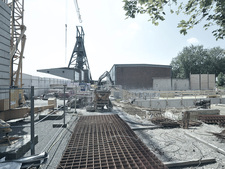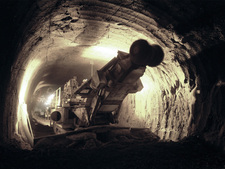-
Topics
subnavigation
Topics
Conversion
- Construction documentation
- Chronology
- Duration of the conversion
- Costs
Time it takes to convert the Konrad mine to a repository
- The construction of the Konrad repository started in 2007.
- Previous plans, dating back to the 1980s, had to be updated.
- According to the DBE, the Konrad repository is to be completed by 2022.
The construction and operation of the Konrad repository was licensed in 2002 by the Lower Saxon Environment Ministry, following a plan-approval procedure having lasted twenty years. On 26 March 2007 the licence for Konrad was also confirmed by the Federal Administrative Court.

![]() Ongoing construction projects at Konrad 1
Ongoing construction projects at Konrad 1
Since then the Federal Office for Radiation Protection (BfS) has been processing the existing planning and licensing documents mainly originating from the eighties. Until then the political requirement of the federal governments had been not to deal with the planning documents for the Konrad repository during the examination by the licensing authority and the court actions, i.e. they could not be adapted to the state of the art of science and technology.
This requirement was based on the apprehension that alterations of the procedural documents could jeopardise the legal certainty of the plan-approval decision. Besides, one wished to avoid unnecessary costs on account of the mine being not suitable or the project being given up.
Parties involved
The overall responsibility for the construction and operation of the Konrad repository is with the Federal Office for Radiation Protection. In 1984 the Federal Republic of Germany tasked the German Company for the Construction and Operation of Repositories for Waste (Deutsche Gesellschaft zum Bau und Betrieb von Endlagern für Abfallstoffe mbH, DBE) with the "planning and construction of federal facilities for the safekeeping and disposal of radioactive waste". By contract the DBE got the monopoly for these tasks. Through the collaboration treaty of 1984 the BfS (formerly Physikalisch-Technische Bundesanstalt, PTB) is thus bound to the DBE.

![]() Fixing strata bolts in the storage roadway
Fixing strata bolts in the storage roadway
Whilst the BfS has the role of operator and builder the DBE carries out the planning and construction of the Konrad repository as a public construction project. The DBE co-ordinates the construction progress and is responsible for the detailed planning. The DBE commissions mainly external companies with the technical works. It is the duty of the DBE to inform the operator, e.g. about the development of costs and the state of implementation. The BfS manages the overall project, co-ordinating the numerous procedures with the competent licensing authorities.
A multitude of other stakeholders are involved in the complex task of constructing the Konrad repository (such as supervisory and licensing authorities as well as contractors). Some of them are only involved for single, defined measures, others for the construction of the core facilities over a longer period of time, others again as superior authorities or supervisory institutions.
Among those authorities whose decisive functions may significantly influence the feasibility of the Konrad mine and the time it will take to convert it into a repository are e.g. the Federal Ministry for the Environment, Nature Conservation, Building and Nuclear Safety (BMUB), the Lower Saxon Ministry for the Environment and Climate Protection (NMU), the Landesamt für Bergbau, Energie und Geologie (LBEG), the Lower Saxon Ministry for Social Affairs, Health and Equation (NMS), the Federal Railway Authority (EBA) and the Loxer Saxon Ministry of the Interior and Sports (NMI). Here you will get a more detailed survey of the institutions involved including their functions.
Updating of previous plans
After the Federal Administrative Court had confirmed the plan-approval decision issued in 2007 by Lower Saxony and after the federal government had been given the all-clear for the construction, the BfS and the DBE could start processing systematically the plans, part of which was over 20 years old, cost accounting and the time required for the construction of the facility according to the state of the art of science and technology. At the same time one needed to implement more than 500 collateral clauses included in the plan-approval decision.

![]() Driving of a gallery with a road header
Driving of a gallery with a road header
The first thing now is to correct the unrealistic assumptions relating to the conversion of the Konrad mine into a repository with which disposal was presented as a cost-efficient method that could be implemented in short time. The adaptation of the plan to the state of the art of science and technology and to the amended legal provisions has shown that it will take longer clearly. With the support of external consultants the BfS and the DBE are working on methods to shorten the time required for construction.
Expert examination
The schedules updated by the DBE stating that the repository will be completed in 2019 were the reason for an expert examination whose conduction was commissioned to the Energiewerke Nord (EWN) by the Federal Ministry of Finance. The resulting report of the Contex Consulting company confirms to a substantial extent the BfS's own analyses indicating that in particular unrealistic assumptions of the eighties and nineties caused the planning corrections. The report, however, also attests the protagonists that the project runs "surprisingly well"
after initial difficulties. "The positive progress in the project is significantly larger than one could assume from the open questions or problems always pushing to the fore."
In their analysis the EWN experts have especially focussed on the co-operation between the BfS and the DBE. Further essential aspects such as interfaces with other protagonists that might lead to time shifting are not considered sufficiently. The BfS evaluates the recommendations of the expert report and has additionally commissioned an external, independent exert to examine the open questions in order to be able to name all things potentially speeding up the construction of the Konrad repository.
Deadline situation
The BfS considers a safe and speedy conversion of the Konrad mine into a repository essential. This is a great challenge for all parties involved where all protagonists need to assume responsibility for their tasks. In the framework of the work carried out during and planned for the conversion phase the BfS controls that the deadlines are met. The company commissioned by the federation with the conversion of the Konrad mine into a repository, the Deutsche Gesellschaft zum Bau und Betrieb von Endlagern für Abfallstoffe mbH (DBE), informed the BfS at the beginning of 2013 that it had noted that additional costs would incur for the remediation of at least one of the two old shafts of the mine. Whether this additional need for remediation is urgently required, what consequences it would probably have for the time the repository will be ready to use or whether the costs or time for the remediation can be reduced, cannot be quantified on the basis of the information available at present.
The BfS has requested the DBE to develop an updated schedule for the completion of the Konrad mine. In October 2013, the DBE announced the estimated costs for the completion of the Konrad mine. The new date given by the DBE for the completion of Konrad is the year 2022. However, the date given by the DBE is not resilient and still subject to considerable uncertainties that are not quantifiable in detail. Therefore, no resilient new date of completion can be given at present. Currently, the DBE cannot say until when these uncertainties can be removed finally. The DBE can only submit a resilient schedule after it has agreed upon the new deadlines for the performances of its subcontractors finally. The BfS has made use of the available means to convince the DBE to submit resilient plans. However, the BfS is bound to a co-operation agreement made by the Physikalisch-Technische Bundesanstalt with the DBE in 1984. According to the contract, the DBE is tasked with the execution, scheduling and cost planning for the construction of the Konrad repository. The original project flow planning of the DBE was based on unrealistic plans from the 1980s and 1990s.
State of 2017.03.13

